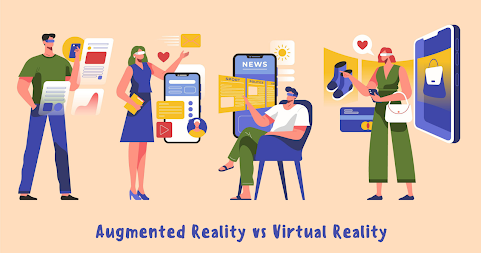
Have you ever imagined
yourself inside a video game? or ever imagined seeing a virtual toy in our real-world via your phone?
Ok, you have! then You’ve
probably heard of Augmented Reality aka AR and virtual reality aka VR before.
But what is it? What is augmented reality? What is virtual reality? Do you
really know?
Let’s know more about AR
and VR and which is better.
Augmented Reality
Augmented Reality (AR)
is when you use a mobile device (like the iPhone) to see virtual objects in a
physical environment. You can move around and the virtual objects will move
with you. AR adds digital elements to a live view often by using the camera on
a smartphone. The best examples of augmented reality experiences include
Snapchat lenses and the Pokémon Go game. AR is one of the biggest technology
trends of the 21st century, and it’s only going to get bigger as AR-ready
smartphones and other devices have become more accessible all over the globe. AR let
us see the real-life environment/virtual events right in front of us in this
real life.
Types of AR
AR is mainly differenced
in three broad types,
- Marker-based
AR
- Marker-less
AR
- Location-based AR
Marker-based AR: Marker-based
AR uses image recognition to identify objects that have been pre-programmed into
your AR device or app. Fiducial markers help the AR device determine the position
and orientation of its camera. A popular example of marker-based AR
includes Augmented Reality QR codes, logos, or product packaging, etc.
Marker-less AR: Marker-less
AR is a bit trickier. Not having markers means that nothing has been pre-programmed
into your device or app, it has to recognize items on the fly. The recognition
algorithm in your device or app looks for patterns, colours, or other features
that might tip it off. The best example of marker-less AR is the Pokémon Go game.
Location-based AR: Location-based
AR uses GPS technology based on your device to project the image so this AR is
commonly known as GPS-based or Geo-based AR. The best example of Location-based
AR is Google Map Street view. This AR has a huge potential in the travel and
tourism industries.
Virtual Reality
Virtual Reality (VR)
is when you put on a headset (like the Oculus Rift) and you’re completely
immersed in an environment. You can move your head to look around, and it feels
like you’re in that environment. VR gives you a virtual tour in the real world,
it implies a complete immersion experience that shuts out the physical world.
Using VR devices such as Oculus Rift or Google Cardboard, users can be
transported into a number of real-world and imagined environments such as the
middle of a war game, alien colony, or even the back of a dinosaur. During 2020
with the COVID-19 restrictions, VR is experiencing an enormous rise. According
to Grand View Research, the global VR market will grow to 62.1 billion dollars
in 2027.
Virtual Reality Software: VR
creates a completely 3-D environment, in 1994 the Virtual Reality Modelling
Language (VRML) was first introduced. VR software works together with VR
hardware to immerse the user into the virtual world. Developers also have to
create interactive components within the environments that look and even feel
like the real deal. Currently, most VR technology uses a JavaScript
application programming interface (API) that provides support for various
virtual reality devices, such as Oculus Rift, Google Cardboard, or OSVR.
Virtual Reality Hardware:
VR
hardware is used in conjunction with the software to provide the illusion of
being in a 3-D environment. Modern VR headset displays are based
on technology developed for smartphones including such as gyroscopes and motion
sensors for tracking head, body, and hand positions; small HD screens for
stereoscopic displays; and small, lightweight and fast computer processors.
Common hardware includes VR glasses, gloves, and other accessories to simulate
other senses like touch and feel.
Augmented Reality vs Virtual
Reality
AR or VR Which is better?
It’s hard to say, we believe that depends on what you want to do. Both
technologies are going to rule our digital life by opening new doorways.
· AR is when you use to see virtual objects
in a physical environment. You can move around and the virtual objects will
move with you. AR technology has a potential market to grow with increasing
reel-real life gaming experiences, digitalization of life, and the tourism industry.
· VR gives us a reel life feel this real
life, we can feel things that are not existing in the practical world. Also, in the near future VR technology is going to see huge growth with increasing VR
gaming studios and movies. Already we have the data to prove that, according to
Grand View Research, the global VR market will grow to 62 billion dollars in
2027.
AR or VR, Which is better?
Both AR and VR are
developing very fast and will grow in the near future. If you ask me if it is
better to go for virtual reality or augmented reality, then I think it is
definitely better to use virtual reality as we get a good experience of
augmented reality in many apps.
ණ Rupjyoti
Follow me: Linktr.ee/ImRupjyoti










